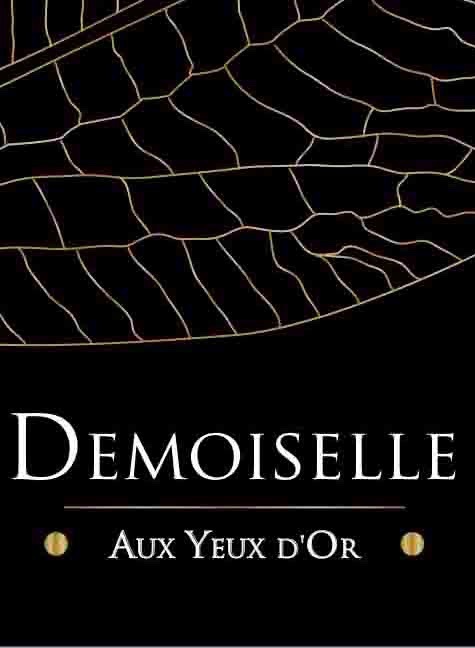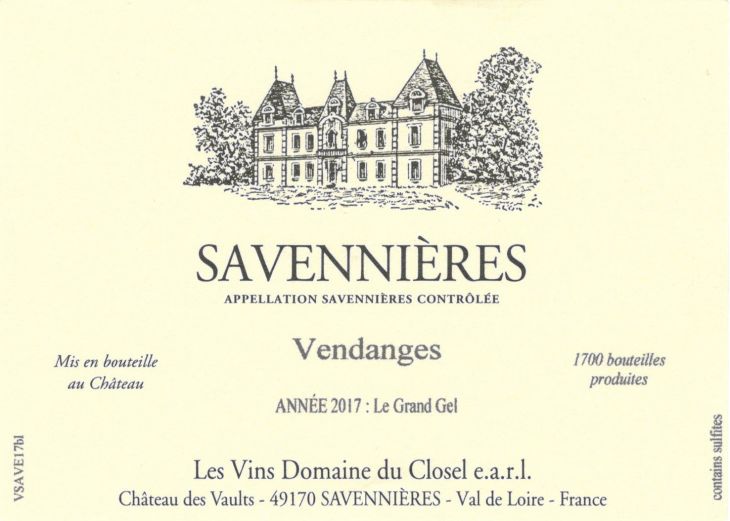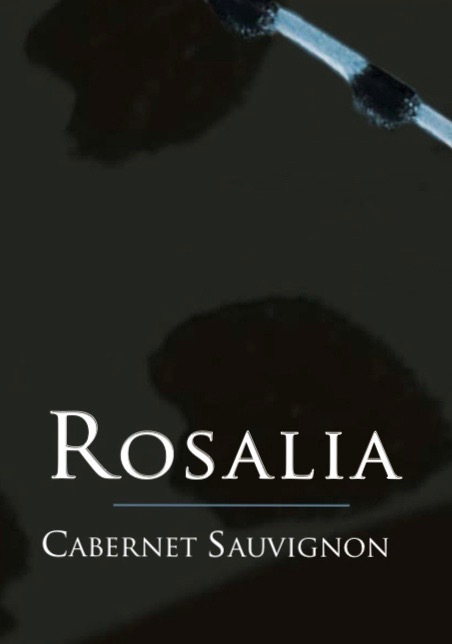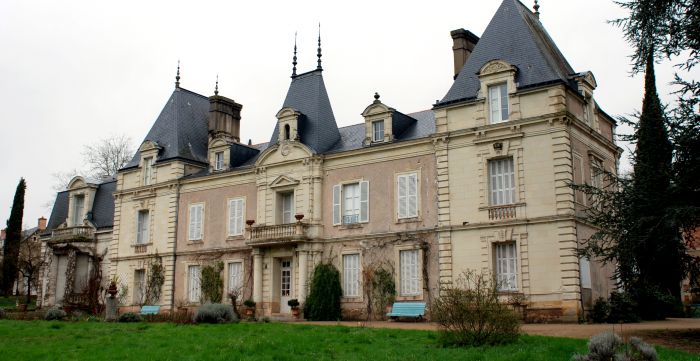
producer profile
31.05.2019
Domaine du Closel Producer Profile
<p>Château des Vaults in <glossary title="930">Savennières</glossary> dates back to 1495, and was inherited by Michèle de Jessey in 1962 from her childless aunt Madame du Closel. Michèle and Jacques de Jessey turned the small family <glossary title="427">estate</glossary> into Domaine du Closel. The entire vineyard is located on the most western hill of <glossary title="930">Savennières</glossary> and includes some of the best <glossary title="760">parcels</glossary> in the <span class="zalup"><span><glossary title="108">AOC</glossary><span>:</span></span></span> <em>Les Caillardières</em> and <em>Clos du Papillon</em>. The <glossary title="1032">topsoil</glossary> is shallow, very warm and consists of purple/green <glossary title="933">schist</glossary> and <span class="zalup"><span><glossary title="910">sandstone</glossary><span>,</span></span></span> enriched with <glossary title="1117">volcanic</glossary> rocks <span class="zalup"><span>(<glossary title="842">quartz</glossary><span>,</span></span></span> <span class="zalup"><span><glossary title="786">phtanites</glossary><span>,</span></span></span> <glossary title="884">ryolites</glossary> and <glossary title="974">spilites</glossary>) in the best areas.</p>
<p>Evelyne de Pontbriand, Michèle and Jacques' daughter, took over the <glossary title="427">estate</glossary> in 2001 after a first career of teaching French literature to adults all over the world. As a lover of botanics and nature, she quickly adopted <glossary title="746">organic</glossary> <span class="zalup"><span><glossary title="1103">viticulture</glossary><span>,</span></span></span> which continues to be an experimental learning process. She is constantly searching for cultural practices best adapted to the austere <glossary title="1026">terroirs</glossary> of <span class="zalup"><span><glossary title="930">Savennières</glossary><span>,</span></span></span> and has deeply changed <glossary title="1104">vinification</glossary> practices in the <span class="zalup"><span><glossary title="254">cellar</glossary><span>.</span></span></span> <glossary title="1104">Vinification</glossary> is done very naturally and with <glossary title="538">indigenous yeasts</glossary>; <glossary title="993">sulfites</glossary> are only added in tiny doses when needed. The wines are raised on <glossary title="590">lees</glossary> from 12 to 26 months. The rhythm of <glossary title="441">fermentation</glossary> is always respected. <br />
<br />
Today the entire <glossary title="427">estate</glossary> has been <glossary title="332">converted</glossary> to<strong> <glossary title="746">organic</glossary> </strong>and <glossary title="160">biodynamic</glossary> practices in order to best express the different <span class="zalup"><span><glossary title="1026">terroirs</glossary><span>,</span></span></span> each producing unique, original and delicious wines. With the help of a Belgian geologist Valerie Closset, all of her <glossary title="760">parcels</glossary> have been inventoried and analysed to understand them better (which ultimately led to each <glossary title="363">cuvée</glossary> sharing the name of the <glossary title="760">parcel</glossary> it came from). A lot of energy has recently been focused on understanding and dealing with <glossary title="474">fungal illness</glossary> in the vines. For <span class="zalup"><span><glossary title="425">esca</glossary><span>,</span></span></span> replacements are done in two phases: the first consists of planting the <span class="zalup"><span><glossary title="869">rootstock</glossary><span>.</span></span></span> About two years later, a <glossary title="941">selection massale</glossary> of <glossary title="281">Chenin</glossary> is grafted from a healthy vine. New plantations are done with material from Lilian Berillon, the first and only <glossary title="746">organic</glossary> <glossary title="773">pépinieriste</glossary> in the world. (<a href="http://www.lilian-berillon.fr/" target="_blank">http://www.lilian-berillon.fr</a>/)<br />
<br />
The other experiments have focused on <span class="zalup"><span><glossary title="834">pruning</glossary><span>:</span></span></span> new plantations are <glossary title="834">pruned</glossary> in the ancient style of <span class="zalup"><span><glossary title="497">gobelet</glossary><span>,</span></span></span> allowing the vine to grow bunches all around and have more <glossary title="430">exposure</glossary> to sun and wind. Instead of being cut, the growing branches are now gently wrapped around the top wire. Evelyne believes that foliage thinning is traumatic to the vines, as leaves are the plant's vital organs. She has quickly noticed a change in the <glossary title="120">aromatic</glossary> <glossary title="756">palate</glossary> of the wines. Much focus has also been dedicated to soil work. Different plants, such as cereals and cloves, have been used as green <glossary title="442">fertilizers</glossary>; the idea is to let indigenous vegetation grow in order to reestablish an authentic <glossary title="1162">biodiversity</glossary> in order to help fight insects and pests.</p>
<p>Evelyne passed unexpectedly in November 2024, mere months after our last visit with her. For decades, she shaped the very existence of Louis/Dressner tours in the Loire and the USA. Incredibly funny, sharp, intelligent and always full of life, energies and ideas, she left Closel, the Loire and our lives a better place. For that: Merci Evelyne!</p>
<p>While there is much still to define going forward, Closel continues today through the de Pontbriand family, with Eveylne’s sons and daughters at the helm. </p>
Article

interview
22.05.2019
An Interview with Evelyne de Pontbriand from 2011
<p><em>This interview with Evelyne de Pontbriand took place on a bus from Los Angeles to San Francisco in March 2011.</em></p>
<p><strong>Tell us about<font color="#7b143e"> Domaine</font><em> </em>du Closel.</strong></p>
<p>Domaine du Closel consists of 16 <span class="zalup"><span><glossary title="523">hectares</glossary><span>:</span></span></span> 13 <glossary title="523">hectares</glossary> of <glossary title="281">Chenin Blanc</glossary> to make <span class="zalup"><span><glossary title="930">Savennières</glossary><span>,</span></span></span> along with two <glossary title="523">hectares</glossary> of <glossary title="216">Cabernet Franc</glossary> and one <glossary title="523">hectare</glossary> of <glossary term="Cabernet Sauvignon" title="217">Cabernet Sauvignon</glossary> reserved for <glossary term="Anjou" title="105">Anjou</glossary> and <glossary term="Anjou" title="105">Anjou</glossary> village. <br />
<br />
I took over the <glossary title="427">estate</glossary> in 2001. At the time, though I had drank a lot of great wine, I had another profession and had never made any! Since then I have less time to drink but more time to make it! <br />
<br />
I took over for my mother; the <glossary title="1089">vigneronne</glossary> before her was an aunt, and before her another woman, so as you can see there are a lot of women in Closel's history!<br />
<br />
<strong>Do you work<font color="#7b143e"> organically</font>?</strong> <br />
<br />
We do. We've always worked very traditionally, but I was the one who pushed that we get a <glossary title="260">certification</glossary> and work in this fashion. We started <glossary title="332">converting</glossary> the vineyards in 2006 and have been <glossary title="260">certified</glossary> as of 2009. Recently we've experimented with <glossary title="160">biodynamic</glossary> <span class="zalup"><span><glossary term="Agriculture" title="78">agriculture</glossary><span>,</span></span></span> but are far from mastering it and aren't <span class="zalup"><span><glossary term="Organic Certification" title="260">certified</glossary><span>.</span></span></span> <br />
<br />
From the beginning of my tenure I began working more or less <span class="zalup"><span><glossary title="746">organically</glossary><span>,</span></span></span> but at the time it didn't seem that important to be <span class="zalup"><span><glossary title="260">certified</glossary><span>.</span></span></span> Over time I came to realize that it gives the consumer a solid reference point, so I decided we should do it. <glossary title="260">Certification</glossary> or not, working <glossary title="746">organically</glossary> reflects my attitude towards nature. I've raised my children this way. My children are <span class="zalup"><span><glossary title="260">certified organic</glossary><span>!</span></span></span><br />
<br />
<strong>Were the vines in good shape before<font color="#7b143e"> converting</font>?</strong><br />
<br />
The vines were always in good shape, except that a lot of them are dying from <span class="zalup"><span><glossary title="425">esca</glossary><span>!</span></span></span> We're constantly replanting, and recently we've purchased graft holders from Southern France; we will attempt the whip and tong graft method in hopes of ridding ourselves of <glossary title="425">esca</glossary> in the future. The <glossary title="500">grafts</glossary> will of course be <span class="zalup"><span><glossary title="941">selections massales</glossary><span>.</span></span></span> <br />
<br />
<strong>What's the work like in the vines?</strong><br />
<br />
It's hard! We work the soil a lot, and we've evolved in that we let everything grow around the vines: we used to let grass grow high, then we started growing various cereals that would later incorporate themselves into the soil, but now we let all of the indigenous flora grow because it really helps us out with insects. <br />
<br />
<strong>What about in the<font color="#7b143e"> cellar</font>?</strong><br />
<br />
We don't do anything in the <span class="zalup"><span><glossary title="254">cellar</glossary><span>!</span></span></span> I just tasted wines that we haven't touched in four months: they taste much better now! We bring in the grapes and everything's already on them so the <glossary title="441">fermentation</glossary> process happens <glossary title="708">naturally</glossary> (in <glossary title="144">barriques</glossary>) and doesn't need me around! We still taste them every once in a while just to make sure everything's ok. The <glossary title="441">fermentations</glossary> are rather long: the "Clos du Papillon" for example <glossary title="441">ferments</glossary> in its <glossary title="144">barriques</glossary> for almost a year. This freaked out my my mother when I first started doing this. But now that she realizes it works just fine, she doesn't care anymore!<br />
<br />
<strong>How do you feel about the Savennières AOC?</strong><br />
<br />
The <glossary title="">AOC</glossary> is getting better and better since I'm now its president! (laughs)<br />
<br />
When I was first elected, I wasn't too sure what I was supposed to do. So I decided to gather all the <span class="zalup"><span><glossary title="1089">vignerons</glossary><span>,</span></span></span> get them drunk, and asked what they expected of me. it worked out great. We debated on what we expected of our <span class="zalup"><span><glossary title="113">appellation</glossary><span>,</span></span></span> and I suppose this is the role of the president: to create an identity and to communicate it to the rest of the world. Another role is to have everyone work together, and I feel that there is a great ambiance between everyone in <span class="zalup"><span><glossary title="930">Savennières</glossary><span>.</span></span></span><br />
<br />
10 years ago there was a vote that permitted <glossary title="1089">vignerons</glossary> in the <glossary term="Commune" title="322">commune</glossary> next to ours to make <span class="zalup"><span><glossary term="Savennières" title="930">Savennières</glossary><span>.</span></span></span> This upped the amount of growers from 12 to 36, and since then we've had no choice but to work together to help our <glossary title="113">appellation</glossary> grow healthily. I'm very happy, because a big group of our <glossary title="1089">vignerons</glossary> are orienting themselves towards <glossary title="746">organic</glossary> and <glossary title="160">biodynamic</glossary> <glossary title="78">agriculture</glossary> in order to make wines that reflect their <glossary title="1026">terroir</glossary> and taste like the area. They aren't bombarding their wines with tons of <glossary title="993">sulfur</glossary> anymore and I can proudly say that there are more and more delicious <glossary title="930">Savennières</glossary> on the market. <br />
<br />
<strong>What's your stance on "<font color="#7b143e">natural wine</font>"? </strong><br />
<br />
I think that everyone's priority should be that the wine be good. I'm not quite sure what "<glossary title="708">natural wine</glossary>" means; so many people claim to be making it, but they're all doing it differently. <br />
<br />
Wine should taste good, but it's important for the <glossary title="1089">vigneron</glossary> to be happy with what he's doing. It's one thing to express a <glossary title="1026">terroir</glossary> or an <span class="zalup"><span><glossary title="113">appellation</glossary><span>,</span></span></span> it's another to express <em>joie de vivre</em> in what you do. <br />
<br />
At the same time, I'll admit that I make and drink wines made in a certain fashion. But there are already so many rules that concretely defining these wines seems arbitrary to me. If the wine is good people are going to buy it. <br />
<br />
If anything, it should be <glossary title="331">conventional</glossary> wines that mention that they use <glossary title="279">chemicals</glossary> on the labels. I find it strange that we're the ones that should alert the consumer that our wines are "pure" and "natural" and others don't have to warn that they are "<glossary title="279">chemical</glossary>" or "poisonous". <br />
<br />
<strong>What do you like to drink?</strong><br />
<br />
I'm a fan of <strong><glossary title="212">Burgundy</glossary></strong>: they have an elegance and a finesse that fascinates me.<br />
<br />
I also love to travel and discover new wines that reflect a <glossary title="1026">terroir</glossary> and a place. Switzerland, Austria and Italy are countries where I've discovered some truly original wines.</p>
Article
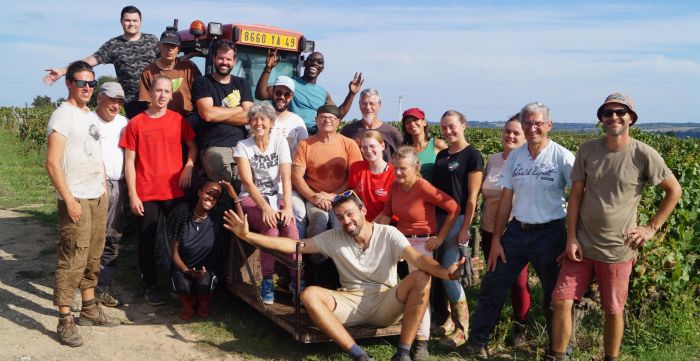
harvest report
04.01.2023
2023 Harvest Report from Evelyne de Pontbriand
<p><strong>November 17th, 2023:</strong></p>
<p>Following a Spring with balanced weather conditions and a generous output from the vines, we were caught off-guard by uncertain weather marked by frequent rainfalls as of mid-June, followed by alternating hot and cool periods. The combination of these factors led to signs of deterioration on some of the grapes from mid-August, and this was reinforced by heavy rains in early September. These conditions forced us to go into a deep reflection to better understand the <glossary term="Vintage" title="1109">vintage</glossary> and to be able to bring the grapes to <span class="zalup"><span><glossary term="Maturation" title="639">maturity</glossary><span>.</span></span></span></p>
<p>Faced with quickly deteriorating sanitary conditions for the vines and incomplete ripening, successive <span class="zalup"><span><glossary term="Pass" title="1144">passes</glossary><span>,</span></span></span> already a practice at the <span class="zalup"><span><glossary term="Domaine" title="400">domaine</glossary><span>,</span></span></span> proved even more essential. The pickers, many of whom we are happy to see come back every year, made the most of their experience in selecting <glossary term="Cluster/Bunch" title="1138">bunches</glossary> of grapes in an always cheerful atmosphere!</p>
<p>We carried out four five <glossary term="Pass" title="1144">passes</glossary> in each block. The first was to remove the sadly rotten bunches and to leave the others to ripen. The next <glossary term="Pass" title="1144">passes</glossary> enabled us to pick healthy, crunchy, or golden grapes little by little. <glossary term="Harvest" title="521">Harvest</glossary> took place from Monday, September 11th to Wednesday, October 4th.</p>
<p>In the spirit of research and innovation we have always had at the <span class="zalup"><span><glossary term="Domaine" title="400">domaine</glossary><span>,</span></span></span> this year we experimented with new <glossary term="Pressing" title="827">pressing</glossary> regiments. Gentler and longer, they enabled us to extract finer juices with great satisfaction. The <glossary term="Native Yeast" title="538">indigenous yeasts</glossary> <glossary term="Fermentation" title="441">fermented</glossary> the <glossary term="Must" title="700">musts</glossary> quickly. They revealed wines with a nice <glossary term="Acidity" title="71">acidity</glossary> and fresh aromas that we had almost forgotten with the roundness of recent years. Now it’s time for the slow <glossary term="Aging" title="74">aging</glossary> process! While the <glossary term="Vintage" title="1109">vintage</glossary> was very demanding in the vineyard, it was nevertheless generous. Thanks to the <glossary term="Yield" title="1129">yields</glossary> obtained, we can go back to a wider range of wines, with refreshing <glossary term="Cuvée" title="363">cuvées</glossary> in white and red, but also a <glossary term="Methode Ancestrale" title="1311">methode ancestrale</glossary> sparkling called "Les Insolites".</p>
<p><img src="https://louisdressner.com/uploads/images/article//1000/f9/54/f954118a20a2a6193ee4571af08b2042.jpg" /><img src="https://louisdressner.com/uploads/images/article//1000/05/60/0560df4b1aa989d7fd8a749fd90c2875.jpg" /><img src="https://louisdressner.com/uploads/images/article//1000/8b/36/8b36d74a14408389695a142b10467310.jpg" /><img src="https://louisdressner.com/uploads/images/article//1000/c9/b7/c9b7a80831dd3ca43a9d90b495e68c50.jpg" /><img src="https://louisdressner.com/uploads/images/article//1000/50/e7/50e7930e5c4cdebe721ffca15ddc6381.jpg" /><img src="https://louisdressner.com/uploads/images/article//1000/84/d1/84d13a990774121c3075dd2536af7eae.jpg" /><img src="https://louisdressner.com/uploads/images/article//1000/96/33/96339662233d54f5ef304a7830a90dd7.jpg" /></p>
Article
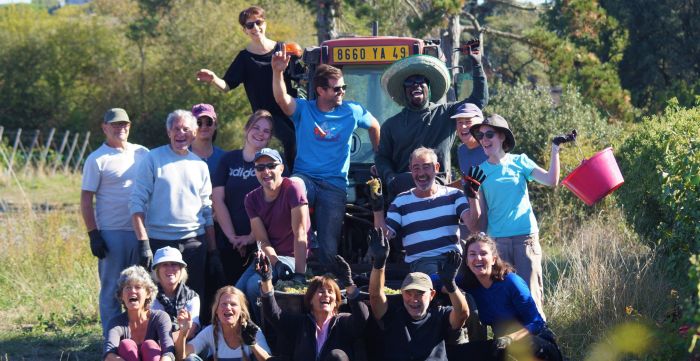
harvest report
22.12.2022
2022 Harvest Report from Domaine du Closel
<p><strong>Evelyne de Pontbriand, October 22nd, 2022.</strong></p>
<p>As for many, the summer was hard on the vines and on all of us with heat waves that blocked the ripening of the grapes on several occasions from the end of June until the end of August. The hydric stress was very important with a deficit of rainfall: 300 mm instead of the usual 400 mm during the whole year.</p>
<p>The vines had <glossary term="Flowering" title="1179">flowered</glossary> in May, which could have led us to expect an early <span class="zalup"><span><glossary term="Harvest" title="521">harvest</glossary><span>.</span></span></span> However, the <glossary term="Veraison" title="1396">véraison</glossary> occurred late (in August) and in a very heterogeneous way. The ripening time of the berries was therefore longer than usual.</p>
<p>The September rains finally allowed us to start <glossary term="Harvest" title="521">harvesting</glossary> on Monday, September 9th. On September 26th, we <glossary term="Harvest" title="521">harvested</glossary> our last <glossary term="Chenin Blanc" title="281">Chenins</glossary> and on October 5th, our last <glossary term="Cabernet Franc" title="216">Cabernet Franc</glossary> and<font color="#7b143e"><b> <glossary term="Cabernet Sauvignon" title="217">Cabernet Sauvignon</glossary></b></font>. Thank you to our cheerful team of pickers! </p>
<p>What a joy to <glossary term="Harvest" title="521">harvest</glossary> healthy, rot-free and very ripe grapes! Antoine, after the various manual <glossary term="Sorting" title="1380">sorting</glossary> operations, tried to ensure the softest and most qualitative <glossary term="Pressing" title="827">pressing</glossary> possible: only the heart of the <glossary term="Pressing" title="827">press</glossary> was kept. The <glossary term="Must" title="700">musts</glossary> quickly revealed aromas of candied fruits and already project us into the richness of the wine, representative of the solar <span class="zalup"><span><glossary term="Vintage" title="1109">vintages</glossary><span>.</span></span></span> In spite of everything, they retain a certain freshness... Is it the interest conferred by the different passages in the vineyards? Or is it the impact of our <glossary term="Savennières" title="930">Savennières</glossary> <glossary term="Terroir" title="1026">terroirs</glossary> / our <glossary term="Biodynamic" title="160">biodynamic</glossary> culture / the length of <span class="zalup"><span><glossary term="Maturation" title="639">maturation</glossary><span>?</span></span></span> These are all questions that climate change is increasingly confronting us with, and which give rise to in-depth reflection on the evolution of our cultivation practices.</p>
<p><span class="zalup"><span><glossary term="Yield" title="1129">Yields</glossary><span>,</span></span></span> impacted by hydric stress, are relatively low, around 18 to 20 <span class="zalup"><span><glossary term="hl/ha" title="528">hl/ha</glossary><span>.</span></span></span> However, we are now paying particular attention to the <glossary term="Aging" title="74">aging</glossary> and quality of the juices. Les Caillardières and le Clos du Papillon are already into our <glossary term="Demi-Muid" title="388">demi-muids</glossary> and the melody of the <glossary term="Fermentation" title="441">fermentation</glossary> process is resounding happily in the <span class="zalup"><span><glossary term="Cellar" title="254">cellar</glossary><span>!</span></span></span></p>
<p><img src="https://louisdressner.com/uploads/images/article//940/25/31/2531e53a5780568835aa714d71c801a6.jpg" /><img src="https://louisdressner.com/uploads/images/article//940/4d/7a/4d7a5a297f53ecca25c90e124a2290de.jpg" /><img src="https://louisdressner.com/uploads/images/article//940/86/06/86060e6197faefac4fe4fd4977aaf404.jpg" /><img src="https://louisdressner.com/uploads/images/article//940/6f/94/6f94709bd738558ff87b95b90e1717af.jpg" /><img src="https://louisdressner.com/uploads/images/article//940/7b/34/7b34836fce4be9860a691f6f1ab57630.jpg" /></p>
Article
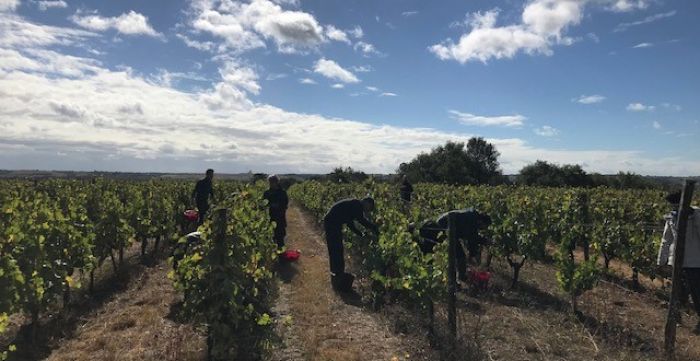
harvest report
22.12.2021
2021 Harvest Report from Domaine du Closel
<p>On October 12, we <glossary term="Harvest" title="521">harvested</glossary> the last grapes of a very challenging <span class="zalup"><span> <glossary term="Vintage" title="1109">vintage</glossary><span>.</span></span></span></p>
<p>Spring was first marked by a major <glossary term="Frost" title="1135">frost</glossary> episode in early April, which caused real crop losses (around 60%). However, our emblematic Clos du Papillon <glossary term="Plot" title="1133">plot</glossary> was relatively spared thanks to the investment of the <glossary term="Estate" title="427">estate</glossary> team (Simon, Vincent, Valentin..) and many friends who came to light the candles for several consecutive nights. This nocturnal work paid off: we obtained a nice <span class="zalup"><span><glossary term="Harvest" title="521">harvest</glossary><span>.</span></span></span> The juices are in <glossary term="Barrel" title="142">barrels</glossary> and we enjoy listening to the sweet melody of the <span class="zalup"><span><glossary term="Fermentation" title="441">fermentations</glossary><span>.</span></span></span></p>
<p> The other <glossary term="Plot" title="1133">plots</glossary> did not survive the shock so well, rainy summer months generated pressure from fungal diseases such as downy <glossary term="Mildew" title="1137">mildew</glossary> and difficulties for the ripening of the grapes. Yields are historically low, from 2 to 18 <glossary term="hl/ha" title="528">hl/ha</glossary> depending on the <glossary term="Cuvée" title="363">cuvées</glossary> and grape varieties... but the quality of the juice is quite satisfactory due to the last sunny days of the <span class="zalup"><span><glossary term="Harvest" title="521">harvest</glossary><span>.</span></span></span> We remain optimistic and are now paying special attention to the <glossary term="Aging" title="74">aging</glossary> of these wines!</p>
Article

harvest report
06.10.2019
2019 Harvest Report from Pauline Lair
<p style="margin:0px; text-align:start; -webkit-text-stroke-width:0px">The winter of 2019 was mild, with records heats at the end of February, resulting in an early start of vegetation. The spring <span class="zalup"><span><glossary term="Frost" title="1135">frosts</glossary><span>,</span></span></span> frequent in April and May, have been rife again this year. The thermometer descended below zero for the first time on April 4th, causing a black <glossary term="Frost" title="1135">frost</glossary> affecting all the <glossary term="Parcel" title="760">parcels</glossary> including those in hillside; then a second time on May 5th, a white <glossary term="Frost" title="1135">frost</glossary> fell on the <glossary term="Plot" title="1133">plots</glossary> at the bottom of the hillside. In total, the vineyard has been damaged up to 60%.<br />
<br />
The spring that followed was rather dry and sunny, giving us good conditions for the development of the flower, with a very small presence of disease such as <span class="zalup"><span><glossary term="Mildew" title="1137">mildew</glossary><span>.</span></span></span> The beginning of the summer was punctuated by stormy episodes and then two heat waves from late June to mid-July. The vines then suffered from <span class="zalup"><span><glossary term="Drought" title="1167">drought</glossary><span>,</span></span></span> giving birth to <glossary term="Cluster/Bunch" title="1138">clusters</glossary> of small berries.<br />
<br />
The <glossary term="Harvest" title="521">harvest</glossary> took place under the sun in just 7 days from the 16th of September onwards. The quality of the <glossary term="-Select term-" title="">harvest</glossary> is superb, with a nice <glossary term="Acidity" title="71">acidity</glossary> and a superb <glossary term="-Select term-" title="">concentration</glossary> on the best <span class="zalup"><span><glossary term="Parcel" title="760">parcels</glossary><span>.</span></span></span> We have the very low <glossary term="Yield" title="1129">yields</glossary> of 13 <span class="zalup"><span><glossary term="hl/ha" title="528">hl/ha</glossary><span>.</span></span></span><br />
<br />
The <glossary term="Fermentation" title="441">fermentations</glossary> are going very well so far, without any input. Only our vigilance on the temperatures and aeration of the <glossary term="Must" title="700">musts</glossary> intervenes in the work of the Nature ...<br />
<br />
This year we are doing a test of <glossary term="Maceration" title="610">maceration</glossary> of <glossary term="Chenin Blanc" title="281">Chenin Blanc</glossary> coming from a pretty <glossary term="Plot" title="1133">plot</glossary> driven in "<glossary term="Gobelet" title="497">gobelets</glossary>", a case to follow!<br />
</p>
Article
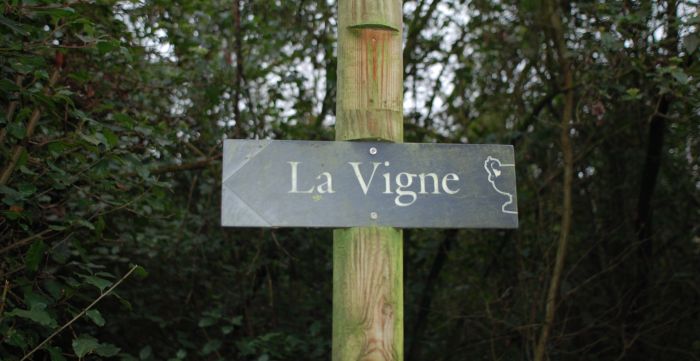
harvest report
21.09.2010
2010 Harvest Report from Evelyne de Pontbriand
<p>We are starting <span class="zalup"><span><glossary title="521">harvest</glossary><span>.</span></span></span> One of our tractors broke.<br />
<br />
I am waiting for a horse to help tomorrow. It is going to be quite an adventure.<br />
<br />
I wanted a horse that could work and also the rest of the time carry me gently over the countryside. Not too high so that I do not need a ladder to climb on it! I probably found the perfect one....we will see.</p>
<p>Kind regards,<br />
Evelyne</p>
Article
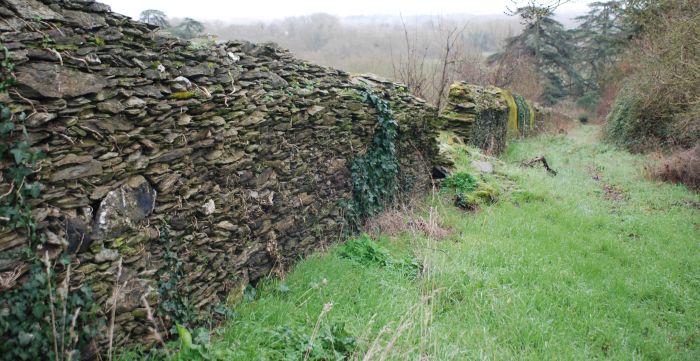
harvest report
19.10.2007
2007 Harvest Report from Evelyne de Pontbriand
<p>Our <glossary title="521">harvest</glossary> is sublime. Having some <glossary title="1137">mildew</glossary> on the leaves (like everyone else), we decided to deal with the problem by letting the vines grow tall, with no trimming. So though it wasn’t very pretty – a bit tousled and disheveled – the grapes ripened marvelously thanks to this heaven-sent tall foliage and a beautiful sunny autumn. Not a trace of rot on the <span class="zalup"><span><glossary title="1138">bunches</glossary><span>.</span></span></span><br />
<br />
We did two or three passes. The <glossary title="1129">yields</glossary> are quite small, about 25 <glossary title="528">hl/ha</glossary> for the Papillon <glossary title="1133">plot</glossary> and 30 for the Jalousie.<br />
<br />
<glossary title="441">Fermentation</glossary> has started nicely all on its own after an easy 12-hour first <span class="zalup"><span><glossary title="843">racking</glossary><span>.</span></span></span><br />
<br />
We began last Monday, October 8th and will finish next Friday, October 18th.<br />
<br />
I am delighted to be working in <span class="zalup"><span><glossary title="160">biodynamie</glossary><span>.</span></span></span></p>
Article

harvest report
03.10.2003
2003 Harvest Report from Evelyne de Pontbriand
<p>As was common in the region this year, <glossary title="521">harvest</glossary> started ahead of schedule on September 16th and ended on October 9th (the day on which it has typically started historically). We began <glossary title="521">harvesting</glossary> grapes for our <glossary title="363">cuvée</glossary> "Les Caillardières" followed by the Clos du Papillon. Our red <span class="zalup"><span><glossary title="1071">varietals</glossary><span>,</span></span></span> <glossary title="216">Cabernet Franc</glossary> and <glossary title="217">Cabernet Sauvignon</glossary> were <glossary title="521">harvested</glossary> on October 6th, 7th and 8th. The last <glossary title="1144">passes</glossary> of<strong> </strong>Clos du Papillon started on the afternoon of the 8th and finished on the 9th.<br />
<br />
Our enthusiastic team of vendangeurs enjoyed beautiful weather until the last week (except for some rain in October) with cool mornings (around 7° C, 45°F) and warm afternoons (around 30°C, 86°F). The traditional Vendanges dinner was held on October 10th, with wine and traditional songs flowing.<br />
<br />
Depending on the site, there were either two or three stages of <span class="zalup"><span><glossary title="1380">sorting</glossary><span>.</span></span></span> The first to protect the <glossary title="1109">vintage</glossary> against potential rot. The second and third ones to select the grapes. The lower number of <glossary title="1380">sortings</glossary> was partly due to a healthy <glossary title="521">vintage</glossary> and also attributed to the fact that there will be no <glossary title="181">botrycized</glossary> grapes this year as they had already attained such high levels of <span class="zalup"><span><glossary title="1381">potential alcohol</glossary><span>.</span></span></span><br />
<br />
We were exceptionally lucky this spring as our vines were shielded from harsh weather conditions that occurred in the area, such as heavy rains and <span class="zalup"><span><glossary title="1136">hail</glossary><span>.</span></span></span> Our <glossary title="521">harvest</glossary> was consequently extremely healthy with no problems of rot being noted.<br />
<br />
However a lack of rainfall and consistent sun during the summer resulted in a few grapes being scorched and to an extent dried out.<br />
<br />
After a very dry and unusually hot summer, a high concentration of sugar and the loss of volume resulted in the <glossary title="700">musts</glossary> having natural degrees of <glossary title="1381">potential alcohol</glossary> ranging from 14.7% to 17.37 % and 4.4 grams per litre of <span class="zalup"><span><glossary title="71">acidity</glossary><span>.</span></span></span> <glossary title="1138">Bunches</glossary> and berries were much smaller than normal, with the latter having thicker skins and more pips. However the 2003 <glossary title="1109">vintage</glossary> produced the kind of <glossary title="1129">yields</glossary> we aim for, ranging from 25 to 30 <span class="zalup"><span><glossary title="528">hectolitres per hectare</glossary><span>.</span></span></span><br />
<br />
The<strong> "</strong>Clos du Papillon" shows a lot of <glossary title="763">passerillage</glossary> and tastes wonderful. We expect to produce a great "Papillon" <glossary title="694">moelleux</glossary> at the level of the 1989 <span class="zalup"><span><glossary title="1109">vintage</glossary><span>.</span></span></span> "Les Caillardières" will be <glossary title="386">demi-sec</glossary> and is already showing incredible aromas of lime and citrus.</p>
Article


